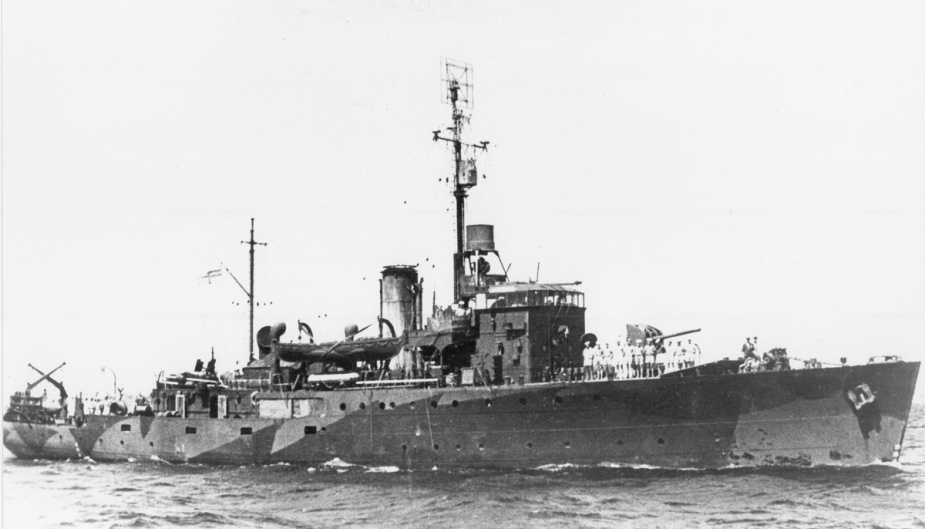HMAS Dubbo (I)
| Class |
Bathurst Class |
|---|---|
| Type |
Australian Minesweeper |
| Pennant |
J251/M251 |
| Builder |
Mort's Dock and Engineering Co Ltd, Sydney |
| Laid Down |
13 October 1941 |
| Launched |
7 March 1942 |
| Launched by |
Mrs EB Serisier, Mayoress of Dubbo |
| Commissioned |
31 July 1942 |
| Decommissioned |
7 February 1947 |
| Dimensions & Displacement | |
| Displacement | 650 tons |
| Length | 186 feet |
| Beam | 31 feet |
| Draught | 8 feet 6 inches |
| Performance | |
| Speed | 15 knots |
| Complement | |
| Crew | 85 |
| Propulsion | |
| Machinery | Triple expansion, 2 shafts |
| Horsepower | 2000 ihp |
| Armament | |
| Guns |
|
| Other Armament |
|
| Awards | |
| Battle Honours | PACIFIC 1941-45 |

HMAS Dubbo was one of sixty Australian Minesweepers (commonly known as corvettes) built during World War II in Australian shipyards as part of the Commonwealth Government’s wartime shipbuilding programme. Twenty were built on Admiralty order but manned and commissioned by the Royal Australian Navy. Thirty six (including Dubbo) were built for the Royal Australian Navy and four for the Royal Indian Navy.
HMAS Dubbo was laid down at Morts Dock Engineering Company, Balmain, Sydney, NSW on 13 October 1941. She was launched on 7 March 1942 by Mrs EB Serisier, Mayoress of Dubbo, and was the first RAN warship to carry the name of the city in the Orana Region of NSW. By the war's end Mort's Dock had constructed fourteen of the sixty Bathurst Class corvettes.
Dubbo commissioned at Sydney on 31 July 1942 under the command of Lieutenant Arthur G Thomas RANR(S).
Dubbo began her seagoing career attached to the escort and anti-submarine group based on Fremantle and remained on this duty until March 1945, a period of two and a half years during which she steamed some 77,000 miles on routine patrols and escort work. There was no enemy activity except for the cruise of a single German submarine, U-862, which entered Australian waters in late 1944. Homeward bound in February 1945, U-862 torpedoed and sank the American ship Peter Silvester west of Fremantle and Dubbo, as one of a search group, spent ten days unsuccessfully searching for survivors.
On 21 March 1945 Dubbo arrived at Darwin from Fremantle, remaining there as guard ship until 4 April when she sailed for New Guinea waters, reaching Port Moresby four days later. Thereafter until the close of hostilities Dubbo took an active part in operations supporting the Australian land forces in New Guinea and the Solomons.
On 25 April she fired her first hostile shots, when in company of HMA Ships Swan and Colac she bombarded Japanese positions on Muschu Island, off the New Guinea coast, in support of the Australian Sixth Division in its drive against Wewak. In May she took further part in the New Guinea operations, bombarding Wewak on 2 May and Kairiru Island the following day.
On 10 May she embarked troops at But and landed them at Dove Bay, east of Wewak, the following day. Fire support to the land forces continued throughout the month. Dubbo succeeded in destroying a number of Japanese gun emplacements during this period while under fire herself, and though she suffered no damage, the Japanese shells frequently fell too close for comfort.
In June 1945 Dubbo proceeded to the Solomons, where she resumed her role of support to the Australian land forces with a series of bombardments of Japanese positions on Buka Island and the Bougainville coast. On 28 June she carried out her final bombardment of the war when she heavily shelled Japanese positions at Manahan. On 10 July Dubbo departed Torokina for Brisbane, bringing her war service to a close.
In August 1945 Dubbo returned to the Solomons area where she carried out some preliminary minesweeping operations. Similar duties in New Britain waters kept her fully occupied during September. In October she returned to Australia to begin a long refit at Brisbane.
In January 1946 she joined the 20th Minesweeping Flotilla and for the next four months was engaged on minesweeping operations in Australian waters.
On 29 April 1946 she entered Sydney Harbour for the last time as a seagoing ship. In her four years of service Dubbo steamed 104,923 miles. She paid off into Reserve at Sydney on 7 February 1947. On 20 February 1958 she was sold for scrap to Mitsubishi Shoji Kaisha Ltd, Tokyo. In June 1958 the Japanese salvage vessel Tokushima Maru departed Sydney for Japan with Dubbo and another former RAN vessel, the repair and maintenance vessel Platypus, in tow.
Note: This video is hosted on YouTube. Department of Defence users will not be able to view this video on the Defence Protected Network.
This cine film has been placed online as part of the Sea Power Centre - Australia’s ongoing archival digitisation program.
Further reading
- The Corvettes: Forgotten Ships of the Royal Australian Navy, by Iris Nesdale - published by the author, October, 1982.
- Corvettes - Little Ships for Big Men, by Frank B Walker - published by Kingfisher Press, NSW, 1996.
- The Australian Centenary History of Defence Volume III, The Royal Australian Navy, edited by David Stevens, Oxford University Press, South Melbourne, Victoria, Australia, 2001.














